After a relaxed start, we headed into the township for swims
(three people – not me!) and caches for us. We stopped in a hotel area and
looked at the features of the grounds. The first we saw was a large model of
the Acropolis, which did seem out of place, although it is in the right country
and was amazing. As we moved along there were models of the Arkadi Monastery
(which we had no problems recognising), the Chania harbour, a castle which is
on the island and a palace also in Crete.
We walked with Jules to their ‘The Secret
War Tunnel’ cache. I had read the listing that said “it's dark, it's dangerous, and it's a bit dirty! Are you
brave enough? You will need good shoes, a torch and a brave
heart......(and I prefer long trousers!)”, but we were not well organised. We
had shorts and no torches so we were grateful that Jules bought a couple, and
my phone worked well. I was scratched and
a bit bloody but less than in some NZ caches. The cave
was used as an ammunition store during WWII and the war tunnel was used to
move ammunition between strategic gun positions high up in the hill.
In
April 1941 these posts were occupied by the 21st Australian Machine Gun
Battalion.
I then walked along the river to look for a 2nd
cache. The route was a track but a rough one. I got to the right area and was
looking. I had just decided it would be at a different level when John arrived
and he found it where I was about to head to. I was in NZ-cache-mode and
thought of where I would have left it. The river will not rise like a NZ one so
the cache had been safely near the waters edge for many years. We had already been looking with no real success for turtles in
the river, but saw 2 on our return. They were too far away for photos but neat
to see in the wild.
The river runs into the sea at the beach area where we were. Sue
and Jules had told us that the top centimetres are just fresh river water and
under is mixed with the warmer sea water. It was a little later they said the
river was mountain fed and cold. We had found that with our feet. My plans to
paddle disappeared with a 12C temperature, but the others all went in far
enough to benefit from the lower warmer temperature, although not without a
number of comments from John about never flying his flag again that had
the others laughing so loudly that we could all hear on the beach.
We then had freshly squeezed orange juice at the tavern before having
a last glimpse of the Acropolis and heading back up the hill.
John and I then drove back into the town to get bread rolls for
lunch, and made a mess of it. We first didn’t find the right supermarket… I
knew it was the wrong one and the right one was near the Bank of Chania but
when I tried to ask google maps for the bank it had us in Chania itself. We
then bought bread from the wrong supermarket, crossed the square and saw a map
and found where the right shop was. I was keen to get the proper items so we
went back over the square and just a bit further to find familiar territory.
Back at the car, we went back over the bridge and followed the road back up
until we were close to home – but on the wrong level. Sue and Jules watched us
drive around the wrong roads, but we did eventually get back safely. I had the
GPS coordinates for the house on the GPS but it was not being helpful. I later
found I could have used google maps, if I had known the address, which I didn’t, because Crete doesn’t have addresses.
After our filled bread rolls on the balcony we headed to the
German War Cemetery overlooking the runway in Maleme. Neither
John nor I can say much about the journey as we snoozed in the back.
The entrance area at the cemetery had signs in Greek, German and
English, some of which were relatively new. We are appreciating the number of
signs in English. The message was that war graves are now more important for
the collective memory as individual grief is less painful with the passage of
time. The cemeteries offer young people lessons in tolerance and cooperation
and that war and violence are not legitimate ways to settle disputes.
We saw similarities with the German cemetery in France, with the
bodies buried in pairs and some stone crosses in the grounds. What we all loved
here were the ice plants which almost looked like a field of tiny poppies with
the red colour of the flowers. Jules and Sue told us they don’t need much
water. More of the plaques here seemed to have the actual names on them but
there were still some with just 2 unknown German soldiers on the plaques.
There was a large iron cross to mark the cemetery and at the back a recent memorial to
some German soldiers who were representing NATO and died in a plane crash in
the White Mountains. There were a number of wreaths on
the site including 1 from Australia , 3 from New Zealand representing
the Battle of Crete Association and Veterans. There were lovely
yellow butterflies flitting from plant to plant in the peaceful surrounds.
We then went further up
the hill to Hill 107 to the west of the town of Maleme overlooking the military
airfield where the key battle was fought, to find a cache placed there. On the way John picked up an old small-calibre cartridge. We went past a large iron cross, then went through olive trees and past
the remains of bunkers. We all went into one that Sue and Jules had been
reluctant to enter in the past being unsure of its stability. It was fine, with
very solid walls and ceiling and enough natural light to not need torches. The
cache was placed at a defensive position occupied by the New Zealanders during
the Battle of Crete, so was a must for us.
We had been thinking of caching friends (the Schroders) who had visited the same German cemetery as we had in France, and
John found a page in the cemetery register to send to them.
I saw a donkey
nearby which seemed to fit the situation. Then we had local sheep milk ice-creams
while Sue helped the owner with an English translation of one of the flavours.
As we had chocolate and almond, no translation was needed. The oddest moment
was being offered a free round of raki even though we only bought an ice-cream
each. We declined gracefully.
At the cemetery parking area was a sign that said
that 4460 dead are in the war graves, having been transferred here from 62 locations.
We also appreciated the words of Albert Schweitzer that were quoted - “The soldiers
graves are the greatest preachers of peace”.
We drove past the airfield looking for a memorial
that was meant to be there but all we saw was barbed wire, keep out signs and
soldiers with machine guns. On our drive past again about 30 minutes later,
John is sure he did see it in a security area, so we did not try to stop.
Instead we had stopped for a newish cache that Jules
and Sue had not yet found. It seemed rather random as it was at a memorial for
road accident visits. The site proved to be a park with a church, fountain,
benches and plaques and with safe parking that we were pleased to see. It was
near an artificial olive tree which was the only part that seemed out of
keeping. In a country with so many olive trees, the point of a fake one escaped
us all. The cache luckily didn’t escape ‘the Cretan Runners’ (Sue and Jules)
and we could all sign the log.
The next visit was the unexpected highlight of the
day. Sue has done heaps of research and planning for us and had found mention
of a WW2 museum she had never heard of before. As the opening time was unclear,
with mention of 5pm or 7pm or in the morning we went there more in hope than
confidence.
It was indeed open and the confusion seemed to have been mainly
because the hours are now extended, as it only opened in 2013. It is under the
church, and the Platanias Church committee and volunteers from the village are
running it on a donation entry.
We were greeted with almost embarrassing delight by
the man on duty because we came from New Zealand. I left he and John to talk
mainly, as they both knew heaps about the New Zealanders role in the Battle of Crete.
During the Battle of Crete, this area had been a
site of major battles, because it was a strategic location for control of land
and sea. After Crete fell, German forces moved into the village and used it as
a local base. The museum was in a series of tunnels and booths built by the
Germans under the Church of St Dimitrios, where they felt they would be safe
from Allied attack. The walls appeared to be limestone so would have been easy
to tunnel in. Local forced workers built the 200m long tunnel, 10 booths, a
main shelter entrance and 2 exits. They used the area to store ammunition and
military equipment. Post war it was used as a pantry by the village because the
temperature was a consistent 20-23C.
The booths had displays of various types, mainly
showing items found in the area along with historic photographs. Sue and Jules
recognised some of the villages in the photos and were awed by the destruction
displayed. There were very sad photos showing the annihilation of whole
villages who had either helped Allied soldiers, Cretan rebels or attacked
German officers.
There is a special sacred olive tree outside the
church. I had missed the details of the story that the custodian had told the
others, but picked it up later. During the Battle of Crete a badly wounded
German pilot had been nursed by the locals, but then died and was buried in a
secret grave near the church. This was the exact spot a German officer chose to
start the excavations of the shelter and tunnels. A church commissioner invoked
the holiness of the olive tree to persuade them to move the entrance so the body
would not be discovered, as this would have meant the probable annihilation of
all villagers.
As we were leaving we were delighted to see the extra
items that had been found in the area and were being cleaned for later display.
It is a wonderful local museum of much more than just local interest.
We were also told the whereabouts of a nearby site
where the Maori Battalion had setup a machine gun bunker. We had been hoping to
set a cache to celebrate our stay in Crete, and this was ideal.
So Sue drove us
part way up the road and then we walked to the top of the hill. There we found
the bunker, and the others went in while I found an old wall that provided a
perfect cache site. I had taken Sue’s bag of caches up so we found a suitably
sized one and recorded the coordinates. John decided immediately to call it ‘Kia
Kaha’ and we were able to submit the cache the next day.
We were all buzzing as we drove back along through the
area that Jules and Sue compared to Blackpool as it is very much a resort area
with hotels, amusement areas and blow-up sea things like seals and turtles. We
then went through the second largest city of Chania to a carpark near the old
Venetian Harbour area. We walked past the old city walls and onto the harbour
front. We stopped for a drink but opted to eat away from the front in spite of
lots of touts encouraging us into their tavernas. We shared starters then all
had our own mains, not all of which were eaten because they were so big. The
raki was also not all consumed, because it was probably the most alcoholic and
rough that we had had. We then had a lovely drive home and were in bed by 11pm.

 Chania, Greece
Chania, Greece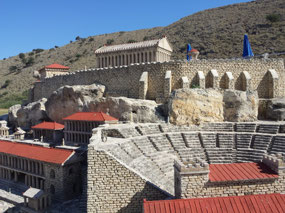
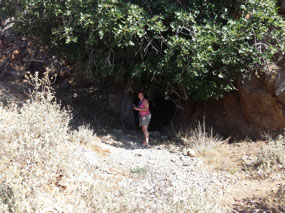
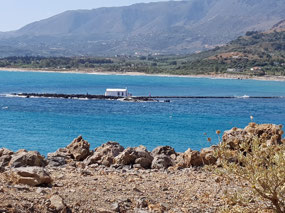
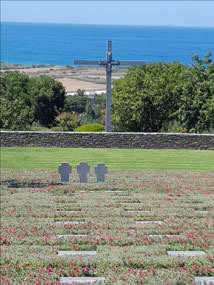
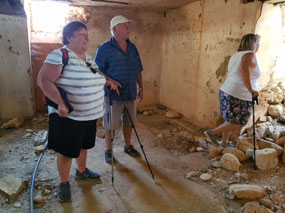
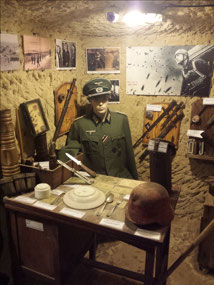
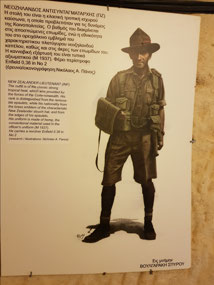
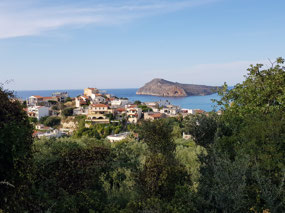
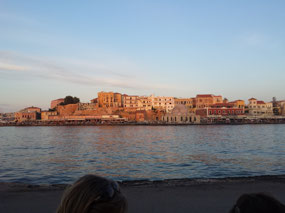






2025-05-22